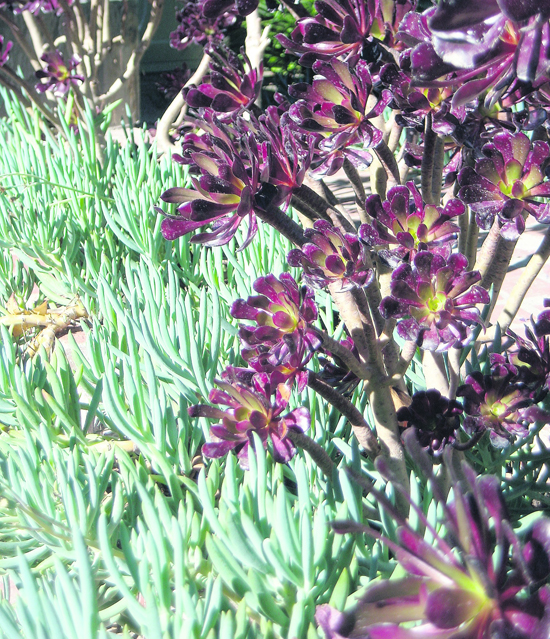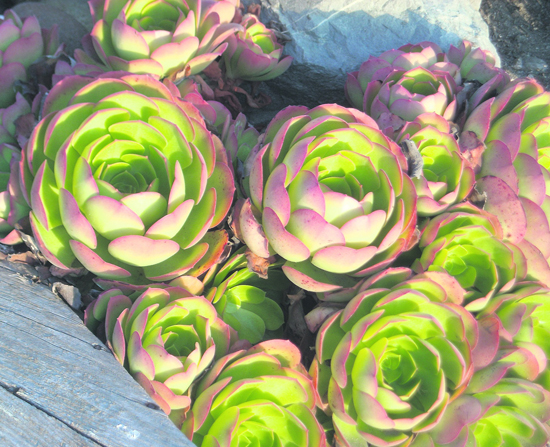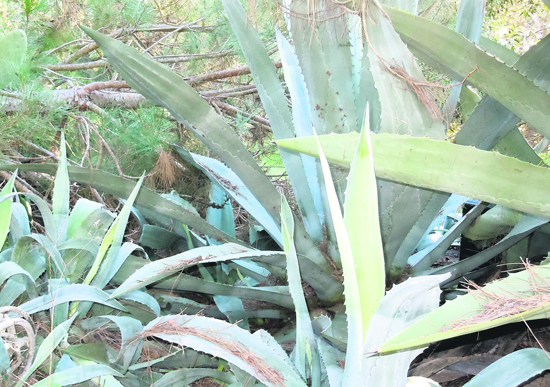| | Published February 2nd, 2011
| Digging Deep with Cynthia Brian-Prickly, Pretty, and Practical
| |  | | Close up of the cornucopia of colors of succulents
|
Aside from celebrating Valentine's Day, February may be the least favorite month of the year for gardeners who live in the continental United States. It is wet, dark, dreary, and not very conducive to digging in the dirt. For me, February is the time to dream of tropical oases and desert charmers.
 My parents gave each of us five children a small parcel of dirt on our farm with instructions to do whatever we wished with our gift. We could plant flowers, vegetables, weeds, or leave the land fallow. My brother chose to grow cactus for three reasons:
My parents gave each of us five children a small parcel of dirt on our farm with instructions to do whatever we wished with our gift. We could plant flowers, vegetables, weeds, or leave the land fallow. My brother chose to grow cactus for three reasons:
 1. they were easy to maintain
1. they were easy to maintain
 2. they required little to no water
2. they required little to no water
 3. they kept away the rest of us
3. they kept away the rest of us
 In my formative years, I didn't have an appreciation for succulents, cacti, or other desert plants. As an adult I'd like to add a fourth superlative to my brother's three - cactus and succulents are beautiful.
In my formative years, I didn't have an appreciation for succulents, cacti, or other desert plants. As an adult I'd like to add a fourth superlative to my brother's three - cactus and succulents are beautiful.
 What are cacti? Part of the Cactaceae plant family, cacti is the plural for cactus, largest and most well known of succulent plants with more than two thousand species growing in the Americas. Because their stems store water, they are excellent choices for plantings in arid, dry conditions or where water usage is restricted. All cacti are succulents but not all succulents are cactus. Succulents store water not only in their stems, but also in their leaves and roots often giving them a fleshy appearance. They developed in the Old World, whereas cactus evolved in our hemisphere. Only succulents that have spines can be called cactus. The good news is that you don't have to live in the desert to grow beautiful succulents and cactus.
What are cacti? Part of the Cactaceae plant family, cacti is the plural for cactus, largest and most well known of succulent plants with more than two thousand species growing in the Americas. Because their stems store water, they are excellent choices for plantings in arid, dry conditions or where water usage is restricted. All cacti are succulents but not all succulents are cactus. Succulents store water not only in their stems, but also in their leaves and roots often giving them a fleshy appearance. They developed in the Old World, whereas cactus evolved in our hemisphere. Only succulents that have spines can be called cactus. The good news is that you don't have to live in the desert to grow beautiful succulents and cactus.
 When our children were quite young, we rode horses at a dude ranch in Arizona where the wilderness overflowed with cacti including thirty foot high Saguaro and two foot wide fish hook barrels. The cholas, with their dangerous needles and sharp barbs jumped out to grab us as we trotted. We didn't like cholas and made a note to never plant them. The kids were each given a tiny cactus in a pot as a souvenir. Over the years they kept their respective cactus on their windowsills. Two decades later, these cacti are still thriving in the same containers, totally neglected, yet elegantly growing. Cacti require almost zero attention and if restricted, grow only as large as the pots in which they are planted.
When our children were quite young, we rode horses at a dude ranch in Arizona where the wilderness overflowed with cacti including thirty foot high Saguaro and two foot wide fish hook barrels. The cholas, with their dangerous needles and sharp barbs jumped out to grab us as we trotted. We didn't like cholas and made a note to never plant them. The kids were each given a tiny cactus in a pot as a souvenir. Over the years they kept their respective cactus on their windowsills. Two decades later, these cacti are still thriving in the same containers, totally neglected, yet elegantly growing. Cacti require almost zero attention and if restricted, grow only as large as the pots in which they are planted.
 My sister gave me a tiny prickly pear and my dad donated an agave. The flowers from the prickly pear are reminiscent of an orange sunset while the pear fruit adds zest to my salads. The nopales (the pads) are delicious as a cooked vegetable, tasting similar to green beans with a bit more fleshiness. (Note to the chef: Use tongs to peel both the pear and the nopales as they are prickly...hence the name prickly pear!) Planted in the ground, both have grown to many times their original size. The five-inch diameter agave gift has grown to twelve feet and spawned many an offspring. I have yet to attempt to make tequila but I thoroughly enjoy its impressive architecture in the landscape.
My sister gave me a tiny prickly pear and my dad donated an agave. The flowers from the prickly pear are reminiscent of an orange sunset while the pear fruit adds zest to my salads. The nopales (the pads) are delicious as a cooked vegetable, tasting similar to green beans with a bit more fleshiness. (Note to the chef: Use tongs to peel both the pear and the nopales as they are prickly...hence the name prickly pear!) Planted in the ground, both have grown to many times their original size. The five-inch diameter agave gift has grown to twelve feet and spawned many an offspring. I have yet to attempt to make tequila but I thoroughly enjoy its impressive architecture in the landscape.
 Since I'm not a fan of needles, my preference leans towards the spineless succulents. Here are a few of my very favorite specimens.
Since I'm not a fan of needles, my preference leans towards the spineless succulents. Here are a few of my very favorite specimens.
 Sedum is a spectacular succulent for hot, sunny spots. With many different varieties, sedums combine color, texture, form, and flowers to interest any gardener. Many are low growing ground covers, others may reach 18 inches or more. Perfect for rock gardens and spilling out of containers.
Sedum is a spectacular succulent for hot, sunny spots. With many different varieties, sedums combine color, texture, form, and flowers to interest any gardener. Many are low growing ground covers, others may reach 18 inches or more. Perfect for rock gardens and spilling out of containers.
 Aeconium aborium- the black rose plant, is green with red edges, grows as a shrub to three feet both indoors and outdoors in full sun. Water every two weeks.
Aeconium aborium- the black rose plant, is green with red edges, grows as a shrub to three feet both indoors and outdoors in full sun. Water every two weeks.
 Crassula argentea-jade plant, is a succulent with tiny white blooms. Don't allow the soil to dry out. They are more finicky indoors but do great outdoors growing in bright light to ten feet. Great container plant, although the deer do love to eat them.
Crassula argentea-jade plant, is a succulent with tiny white blooms. Don't allow the soil to dry out. They are more finicky indoors but do great outdoors growing in bright light to ten feet. Great container plant, although the deer do love to eat them.
 Sempervivum tectorum-hens and chicks produce clusters of rosettes which are the hens with the smaller rosettes being the chickens. Foliage can be red, light green, or a combination thereof. Easy to grow, they spread to two feet or more. Having always raised poultry, I adore this species of succulents. Propagate by picking off the chicks and planting elsewhere.
Sempervivum tectorum-hens and chicks produce clusters of rosettes which are the hens with the smaller rosettes being the chickens. Foliage can be red, light green, or a combination thereof. Easy to grow, they spread to two feet or more. Having always raised poultry, I adore this species of succulents. Propagate by picking off the chicks and planting elsewhere.
 Agavoideae-agave plants are popular as ornamentals with their long, thick flesh leaves ending in a sharp point with a spine. Agaves are not cacti and they are not related to aloe. Stalks, flowers, leaves, and sap are edible. Only the Weber blue agave plants make tequila labeled as 100% blue agave. Be aware that getting the juice on your skin may cause a severe rash and acute dermatitis. Handle agaves with gloves and care.
Agavoideae-agave plants are popular as ornamentals with their long, thick flesh leaves ending in a sharp point with a spine. Agaves are not cacti and they are not related to aloe. Stalks, flowers, leaves, and sap are edible. Only the Weber blue agave plants make tequila labeled as 100% blue agave. Be aware that getting the juice on your skin may cause a severe rash and acute dermatitis. Handle agaves with gloves and care.
 Aloe-aloe vera is plant that needs to be in a container in everyone's kitchen. It's an excellent first air remedy for burns, bites, and scratches. I break off a leaf and pour the thick gel directly on the wound. Aloe vera relieves itching and pain almost instantly.
Aloe-aloe vera is plant that needs to be in a container in everyone's kitchen. It's an excellent first air remedy for burns, bites, and scratches. I break off a leaf and pour the thick gel directly on the wound. Aloe vera relieves itching and pain almost instantly.
 Schlumbergera-Christmas Cactus is a favorite of every family for the holidays. The tips of the plant begin to grow darker, then magically a flower bursts into bloom in shades of pink, red, or white. They need more care than other cactus and are worth the trouble.
Schlumbergera-Christmas Cactus is a favorite of every family for the holidays. The tips of the plant begin to grow darker, then magically a flower bursts into bloom in shades of pink, red, or white. They need more care than other cactus and are worth the trouble.
 Hylotelephium-Formerly called a Sedum, Autumn Joy is a favorite low maintenance mainstay in my garden containers. Deep rose enation are borne on burgundy stems with green-blue leaves. Sedum is best pruned back in spring, then it sprouts again bearing clusters of flush pink flowers from summer through fall. You can break off a stem to plant anywhere. It grows with little water.
Hylotelephium-Formerly called a Sedum, Autumn Joy is a favorite low maintenance mainstay in my garden containers. Deep rose enation are borne on burgundy stems with green-blue leaves. Sedum is best pruned back in spring, then it sprouts again bearing clusters of flush pink flowers from summer through fall. You can break off a stem to plant anywhere. It grows with little water.
 Stenocereus thurberi-organ pipe cactus is covered in spines and can grow to twenty-five feet with numerous ribs, but in a container it will remain small, which is the only way I'd want this cactus around. It boasts a pretty white cactus flower and requires only a few drops of water a month to thrive in a pot.
Stenocereus thurberi-organ pipe cactus is covered in spines and can grow to twenty-five feet with numerous ribs, but in a container it will remain small, which is the only way I'd want this cactus around. It boasts a pretty white cactus flower and requires only a few drops of water a month to thrive in a pot.
 How to grow succulents
How to grow succulents
 There are thousands of succulents and cacti that will adapt well in Lamorinda gardens. Choose the forms, colors, and flowering patterns that you prefer. Succulents are excellent in rock gardens as well as containers and cacti may used as privacy hedges. Peruse your local garden center, ask lots of questions, and get the information you need about growing patterns, especially height, width, and root depth. Succulents prefer bright light, thriving in cool nights with warm days. They aren't that fussy about soil as long as it drains well. Add sand or perlite to increase aeration and drainage. In the summer months, succulents are thirsty. In winter, they may only require water every couple of months. Overwatering is the main cause of the demise of succulents. Better dry than die!
There are thousands of succulents and cacti that will adapt well in Lamorinda gardens. Choose the forms, colors, and flowering patterns that you prefer. Succulents are excellent in rock gardens as well as containers and cacti may used as privacy hedges. Peruse your local garden center, ask lots of questions, and get the information you need about growing patterns, especially height, width, and root depth. Succulents prefer bright light, thriving in cool nights with warm days. They aren't that fussy about soil as long as it drains well. Add sand or perlite to increase aeration and drainage. In the summer months, succulents are thirsty. In winter, they may only require water every couple of months. Overwatering is the main cause of the demise of succulents. Better dry than die!
 Cacti are macho plants. Use caution with these menacing monsters. Those spiky thorns protect the plants from animals and humans. Always wear long sleeves, pants, and gloves when handling cacti. My sister created a cacti fence around her barn to keep out the predators. It works! Succulents make wonderful dormitory gifts for university students who want a bit of nature inside but have little time for nurturing.
Cacti are macho plants. Use caution with these menacing monsters. Those spiky thorns protect the plants from animals and humans. Always wear long sleeves, pants, and gloves when handling cacti. My sister created a cacti fence around her barn to keep out the predators. It works! Succulents make wonderful dormitory gifts for university students who want a bit of nature inside but have little time for nurturing.
 Looking back, my brother made a great choice for his plot of land. As water prices rise, we may be wise to look to these prickly, pretty, and practical plants as a viable alternative to living green.
Looking back, my brother made a great choice for his plot of land. As water prices rise, we may be wise to look to these prickly, pretty, and practical plants as a viable alternative to living green.


|
 | | Succulent, Aeconium Aborium Photos Cynthia Brian
|  | | Who says cactus don't grow in pine groves? Pine nuts and tequila anyone?
Photo Cynthia Brian
|  | | Cynthia Brian
| | | | | | | Advertisement | | |
| | | | | | Comments | | | | | |  | | |
| | |  | | |
| | | | |








